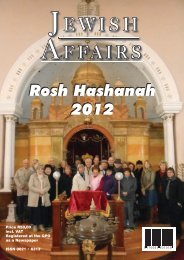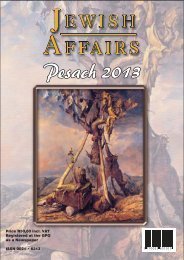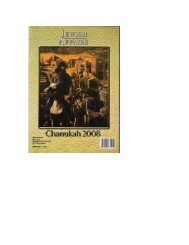Rosh Hashanah 2009 - South African Jewish Board of Deputies
Rosh Hashanah 2009 - South African Jewish Board of Deputies
Rosh Hashanah 2009 - South African Jewish Board of Deputies
- No tags were found...
You also want an ePaper? Increase the reach of your titles
YUMPU automatically turns print PDFs into web optimized ePapers that Google loves.
JEWISH AFFAIRS ROSH HASHANAH <strong>2009</strong>How then can the <strong>Jewish</strong> doctor resolve thedilemma between our moral obligations to showcompassion, in accordance with the aforementionedRabbinical injunctions, while at the same timefulfilling ethical commitment to disclosing the truth?Awareness by the doctor <strong>of</strong> the coping or defensemechanisms <strong>of</strong> the patient, and the psychologicalstages which patients diagnosed with serious or lifethreateningillness experience, provide a model orbasis for an approach by the doctor. In her widelyacclaimed, groundbreaking book On Death andDying, Elizabeth Kubler-Ross 7 describes the stages<strong>of</strong> denial, anger, depression, and ultimate acceptance.Denial is the strongest human defense, and duringthis stage there is disbelief <strong>of</strong> the seriousness <strong>of</strong>illness. By way <strong>of</strong> example, patients may want toblock out the fact that they have cancer and <strong>of</strong>ten itwould be appropriate for the doctor initially to useterminology such as ‘growth’ or ‘tumor’. Byinforming the patient <strong>of</strong> the diagnosis the doctor isfulfilling his/her commitment to telling the truth. Byinitially withholding information about possibleserious implications or prognosis <strong>of</strong> the illness, thedoctor allows the patient time to gather him/herself:by so doing, he/she respects the patient’s defenses <strong>of</strong>denial and shows compassion towards the patient.In the course <strong>of</strong> time, the patient’s defenses <strong>of</strong>denial gradually diminish and there is acceptance <strong>of</strong>the true nature <strong>of</strong> the illness. The general principle <strong>of</strong>the doctor’s approach, therefore, is that it is usuallypossible to temporise, and impart the news in stagesin keeping with the patient’s defenses, withholdingsome <strong>of</strong> the truth when necessary, and allowing thepatient time to set his/her own pace and mobilize lessradical defenses as s/he becomes adjusted to theseriousness <strong>of</strong> the illness. The social worker MargaretAbeles states that Rabbinic law says, “…one shouldnot divulge the truth”. She adds, however, “…thereare also sources that teach us that if the patient is sodisturbed by knowing it is permissible to tell him/her, as the knowledge will be a source <strong>of</strong> relief.Therefore, it seems that <strong>Jewish</strong> law says that we mustbe guided by our patients”. 8 Rabbi Jacobovits putsthe <strong>Jewish</strong> approach succinctly: “…the patient shouldbe allowed to buy time, gather himself and mobilizehis resources…” This demonstrates compassion andis in keeping with <strong>Jewish</strong> humanistic philosophy.The principles embodied in the above not onlyfacilitate doctors’ communication with their patients,but also help to resolve many <strong>of</strong> the moral, ethical,and religious dilemmas facing them.End <strong>of</strong> Life Decision-MakingDoctors’ undergraduate training emphasizes theimportance <strong>of</strong> making diagnoses and curing illness,be it heart attack, pneumonia, or for that matter anyillness, ailment, or injury. When cure is no longerpossible, such as in chronic refractory or terminalillness, and ultimately in the dying process, relief <strong>of</strong>pain and suffering become preeminent. The adagecoined by John Fry, a veritable doyen <strong>of</strong> familypractice, to “cure sometimes, relieve <strong>of</strong>ten, andcomfort always”, becomes singularly appropriate.Caring for our patients’ medical problems and caringabout them as human beings, a paradigm for alldoctors in all disciplines <strong>of</strong> medicine, becomes thedefined role and elevates the role <strong>of</strong> curing to that <strong>of</strong>healing.In the case <strong>of</strong> <strong>Jewish</strong> patients, there is the addedresponsibility for the doctor to have insight andsensitive to religious practices and Halachicimperatives, particularly so in terminal illness, andwhere life and death decisions present difficultdilemmas. Two cases are here presented whichillustrate the role the doctor can play in resolvingsuch problems.Case no.1Mike, aged 76, suffered severe head injuries forwhich he was hospitalized and subjected to brainsurgery. Following the surgery, he remained deeplyunconscious and had to be supported by artificialventilation. The family who gathered around him ona daily basis suffered unendurable stress at observingtheir beloved Mike in so heart-rending a situation. Inthe company <strong>of</strong> their Rabbi, who was a close familyfriend, they would sit praying at Mike’s bedside.After two days, it was quite apparent that Mike’scomatose state was irreversible and he would notsurvive. The family’s agony had now reachedbreaking point and they were consulted aboutterminating life-support. This provoked a seriousdilemma in view <strong>of</strong> the Halachic constraintsexpressed by their friend, the Rabbi.The doctor consulted with the Rabbi, who withsublime generosity, insight and humanity, agreed todistance and recuse himself from any decisionmaking,while the same time reassuring the doctorthat he would accord Mike a traditional Orthodoxburial whatever decision would be taken by thedoctor and family. The doctor visited the family andcomforted them by relating the Rabbi’s sentiments,and advised them that the recommendation <strong>of</strong>terminating life support rested on the doctor’sshoulders, and that the Rabbi could not be expectedto participate in such decision-making. The familyagreed to the medical advice and the painful decisionto turn <strong>of</strong>f the ventilation was made. Within sixminutes <strong>of</strong> doing so their beloved Mike’s lifeterminated. The family left Mike’s bedside andreturned home in the comfort <strong>of</strong> their togetherness.Termination <strong>of</strong> life and euthanasia are anathemato Judaism. The debate on termination <strong>of</strong> life in theterminally ill has prevailed over centuries and as farback as the Talmud which states that to hasten thedeath <strong>of</strong> a dying person is prohibited. More recentRabbinic literature <strong>of</strong> the treatment <strong>of</strong> the terminallyillis that <strong>of</strong> Rabbi Feinstein, 9 a noted bioethicist, whostated that for a patient with pain and suffering whocannot be cured and cannot live much longer, it is notobligatory for physicians to administer medicationto prolong life and suffering, and nature may beallowed to its course. Therefore, although it isprohibited to administer medication to hasten death,46











